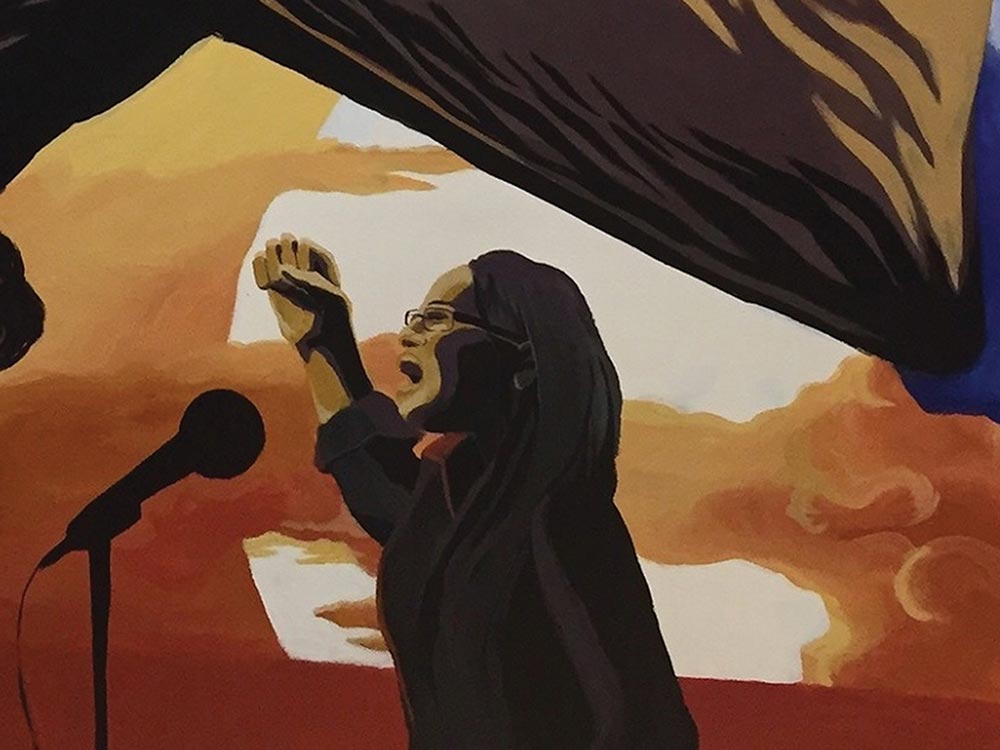
Click here to download this article as it appears in the magazine, with accompanying artwork.
This article is from the Fall 2021 issue of the Nonprofit Quarterly, “Climate Justice: A Movement for Life.”
On November 29, 2018, a large crowd of protestors disrupted a meeting of the California Public Utilities Commission. They demanded that the agency hold Pacific Gas & Electric Company (PG&E) accountable for causing a rash of wildfires that were jeopardizing life in Northern California. The commissioners called in the state police to clear the vocal protestors from the normally staid proceedings; shortly thereafter, the commissioners advanced a $6.1 billion credit rescue of one of the most powerful monopoly utilities in the nation.1
Just weeks before, smoke and ash blanketed Northern California, turning it into a gray toxic soup. On November 8, faulty PG&E transmission lines sparked what became at that time the largest wildfire in California history: Over seventeen days, the utility-caused Camp Fire killed eighty-five people, consumed more than one hundred and fifty thousand acres, and incinerated eighteen thousand buildings. The town of Paradise was turned into a living hell.2
Energy—that essential resource driving all human activity, from producing the essentials of life to transportation, communications, creative arts, and beyond—is currently at the core of the most critical issues we face today.
A year-and-a-half later, on June 16, 2020, PG&E pleaded guilty to eighty-four counts of involuntary manslaughter.3
The Camp Fire was just one of seventeen wildfires in 2017 and 2018 for which PG&E was found responsible, amounting to an estimated $30 billion in damage.4 All the while, the utility paid out executive bonuses and $4.5 billion in dividends to shareholders.5 Two months after the disruption of the Commission meeting, PG&E filed for Chapter 11 bankruptcy, leaving wildfire survivors and ratepayers picking up the $30 billion tab.6
PG&E represents just one example of a legacy energy model that has long dominated electric power distribution in the United States. After a rash of climate-induced disasters that have exposed this system’s vulnerabilities and inequities, a grassroots movement is growing to radically transform it—one that sees a transition to renewable energy technology as part of a broader restructuring and transformation of the energy system.
Energy
Energy—that essential resource driving all human activity, from producing the essentials of life to transportation, communications, creative arts, and beyond—is currently at the core of the most critical issues we face today: economic inequality, racial injustice, ever-declining health, ecosystem destruction, and, of course, the climate crisis.
We face a climate crisis largely because energy in our economy functions as a commodity instead of a life-giving resource. The climate crisis is an inconvenient truth for capitalism—predicated on the notion that the planet is an infinite reserve, here for our use, to be plundered, poisoned, and degraded, and where anything not deemed fit for the commodity market can be destroyed as “collateral damage.”
Against this existential threat, people are fighting back, as they always have. Most prevalently, Indigenous peoples around the world have done their utmost for centuries to be good stewards of the Earth, its species, and resources, and to prevent the ecocide currently being perpetrated globally in the name of “development.” The recent Green New Deal and Red Black and Green New Deal go a good way in this direction; and the Red Deal, authored by The Red Nation, explicitly centers the frontline climate justice work as advancing “the radical transformation of all social relations between humans and Earth.”7
Moving Beyond Fossil Fuels
Thanks in large part to the sustained efforts of grassroots climate advocacy groups, significant parts of the U.S. political and corporate establishment are beginning to recognize the need—in words if not always in actions—to transition our energy system away from fossil fuels.
Shareholders are challenging their peers at oil corporation annual meetings. Parts of the Democratic Party appear to no longer be coddling the Washington oil lobby. Wall Street is trying to figure out how it will dispose of stranded fossil fuel assets as investors are beginning to jump ship. The Biden administration is taking positions on climate that, limited as they are, no other administration has taken before, such as with Executive Order 14008, Tackling the Climate Crisis at Home and Abroad.8
At the same time, many grassroots climate activists are asking questions about how their efforts can and must move beyond the basic goal of a technical transition to clean energy. They are asking, “Who will determine what the transition to renewable energy looks like?” “Who will control it?” “Who will benefit, or be hurt?”
A transition to renewable energy really means a transition to electricity—electricity generated from renewable energy sources. For the most part, that means relying on the legacy system of electric utilities and the set of institutions that underwrite and support them.
And that’s a huge problem.
A transition to renewable energy through this corporate, centralized utility system does not qualify as a “solution” to the climate crisis. A different transition to renewable energy is needed.
A Decaying, Outmoded, Centralized Energy Model
For the electric utilities and their financial backers, a transition to renewable energy is mainly an opportunity to extend the legacy fossil fuel energy model to renewable sources of electricity. For them, a transition to renewable energy sources means a switch to big solar plantations and large wind farms, generally remote from electricity customers and dependent on existing and new long-distance transmission infrastructure.
President Joe Biden has virtually codified this approach in his signature infrastructure package. The bill sets aside $73 billion of investments in thousands of miles of power lines that would carry electricity from remote wind turbines and solar farms to faraway electricity users.9
Ownership of that grid infrastructure and energy decision making would remain centralized in powerful financial interests. In most cases, this means Wall Street financing with political support from state regulatory agencies.
We’ve seen just how harmful the impacts of this legacy system can be. Across the United States, hundreds of thousands of people—sometimes millions—have been left without power for days or weeks as unprecedented storms bring down transmission lines. In 2012, Hurricane Sandy left many New Yorkers without power for two weeks.10 Texas residents suffered prolonged outages this past February that left 4.5 million homes and businesses without power, caused over 210 deaths, and resulted in unprecedented spikes in the cost of electricity—all due to failure of the utility system to prepare for a cold snap that was predicted decades ago.11
In Puerto Rico, in 2017, Hurricane Maria resulted in nearly three thousand deaths, according to a study commissioned by the Puerto Rican government, with many of those deaths the direct result of a lack of electricity that left residents without power for medical equipment, food, water, and shelter for months after the hurricane.12
“The storm laid bare the vulnerabilities of our transmission and distribution system and an electricity model that left our communities exposed to power failures,” explains Ruth Santiago, an environmental and community lawyer who works with numerous groups such as Comité Diálogo Ambiental. “The U.S. colonial relation to Puerto Rico—Black and Brown people—has created conditions of dependence on centralized, fossil-fired generation that dramatically amplified the impact of the storm and resulted in the death of so many Puerto Ricans.”13
These impacts illustrate two key truths.
The first is that increasing reliance on remote sources of electricity and long-distance transmission infrastructure, which put millions of people at risk, is exactly the wrong strategy for mitigating the impacts of climate change—it amplifies these impacts.
The second is that low-income communities and communities of color—those with the least resources and most at risk from electricity shutoffs—bear the brunt of the failures of centralized energy systems, intensifying the racialized impacts of these failures.
In short, a transition to renewable energy through this corporate, centralized utility system does not qualify as a “solution” to the climate crisis. A different transition to renewable energy is needed.
Sign up for our free newsletters
Subscribe to NPQ's newsletters to have our top stories delivered directly to your inbox.
By signing up, you agree to our privacy policy and terms of use, and to receive messages from NPQ and our partners.
An Alternative Vision: Energy Democracy
Energy democracy is a worldwide movement of working people, low-income communities, and communities of color working to take control of energy resources from the corporate energy establishment and use those resources to empower their communities. It is a movement focused on energy justice.
As Crystal Huang, coordinator of the Energy Democracy Project, a collaboration of close to forty affiliated energy democracy organizations, explains, “Energy democracy is about local communities taking in their own hands the responsibility of building a cleaner and more equitable future. Our communities seek solutions that address the economic and racial inequalities that an otherwise decarbonized economic system would continue to perpetuate.”14
Energy democracy implies a profound shift in our relationship to energy: how energy use impacts the ecosystem, how it impacts economic development, and how it impacts racial disparities. “The question is whether we will build [the new energy] system on a foundation of justice and equity or whether we will build that system using the very same tools that landed us in this disaster in the first place,” writes Shalanda Baker, deputy director for energy justice and secretarial advisor on equity at the U.S. Department of Energy, and author of Revolutionary Power: An Activist’s Guide to Energy Transition.15
Baker and other energy democracy advocates identify with a growing climate justice movement: activists who see opposition to fossil-fuel capitalism as key to transforming our economic system more deeply. That movement is an outgrowth of the environmental justice movement, which for thirty years has sought to combat the disproportionate harmful impact of energy development on low-income communities of color.16 Climate justice and energy justice stand for community health, community resilience, community control over resources, and community empowerment. Energy democracy is part of the broader struggle for social and economic justice.
A New, Decentralized Energy Model
To realize the broad benefits that renewable energy makes possible, we need to shift from the old, centralized energy model to a new, decentralized energy model.
In recent years, a conscious energy democracy movement has emerged that sees the decentralized energy model as the way to put environmental, racial, and economic justice at the forefront of the transition to renewable energy.
Decentralized control of renewable energy resources is made possible by the fact that renewable energy resources, by their very nature, are distributed. Solar energy, wind, geothermal energy, energy conservation, energy efficiency, energy storage, microgrids, and demand response systems are energy resources that can be found and developed in all communities.
The decentralized energy model emphasizes the deployment of distributed energy resources and investment in our communities: local economic development, local jobs, business opportunities, local workforce development, and local wealth building. This model is the polar opposite of the centralized energy model in operation today. It calls for control, ownership, and decision making regarding renewable energy resources to reside in the community rather than in remote corporate boardrooms. It is the basis for a democratized energy system centered on justice.
A Growing Movement
In recent years, a conscious energy democracy movement has emerged that sees the decentralized energy model as the way to put environmental, racial, and economic justice at the forefront of the transition to renewable energy. The base of this movement is mainly local initiatives led mostly by women in communities of color across the United States. Many of these are affiliated with the Energy Democracy Project, a collaboration that grew out of a 2019 national Strategic Convening on Energy Democracy.
The movement’s initiatives take many forms, such as:
- organizing for installation of solar panels on residential properties in low-income communities across the United States
- promoting the development of a new generation of consumer energy cooperatives in low-income and BIPOC communities nationally
- advocating for best operational practices to promote community benefits and equity among California’s twenty-three local public Community Choice energy agencies
- taking on major private utilities to democratize energy and build community energy resilience
- working to return the nation’s rural electric cooperatives, predominantly in poor regions of the United States, to democratic governance
This emerging movement has even spawned a congressional resolution, House Resolution 457, introduced by Representatives Cori Bush (D-MO) and Jamaal Bowman (D-NY). Their resolution to promote public electric utilities also aims to “facilitate the development of community owned and controlled clean energy resources” and to “create transparent and equitable systems for public participation and cultivate processes for community governance over energy production, distribution, and procurement decisions.”17
Private Utilities Stand in the Way
But private investor-owned electric utilities (IOUs), responsible for about two-thirds of all national electricity sales, have for years waged a relentless campaign to undermine the decentralized, justice-centered approach to energy generation and distribution.
Take on-site solar generation. Often called rooftop solar, it refers to property owners installing solar panels—local clean energy—to provide the electricity needed on their property. Many states have established programs to encourage on-site solar under policies known as net energy metering, which establishes compensation rates for solar customers when they export excess electricity produced by their solar panels to the grid.
The IOUs have banded together to oppose these policies, regarding on-site solar generation as a threat to their centralized energy model—a “utility death spiral,” as they have called it, that would put the utilities out of business.18 The IOUs linked up with the right-wing lobby, the American Legislative Exchange Council (ALEC), to introduce more than seventy bills in thirty-seven states to weaken solar net metering policies.19
The IOUs and ALEC have falsely argued that on-site solar users increase the cost of electricity for non-solar customers. They have framed this purported “cost shift” as hurting low-income households: effectively invoking a racial wedge to pit solar adopters and non-solar customers against each other, an effort to undermine the growth of on-site solar.20
In response, supporters of decentralized energy have recently scored at least one significant victory. On June 3, 2021, a broad statewide coalition of activists defeated an IOU attempt to bring on-site solar to a screeching halt in California. The state’s IOUs called for passage of AB-1139—an effort right out of the IOU/ALEC playbook, to address what the utilities claim to be “inequities” by making it uneconomical for customers to invest in on-site solar.21
But a massive mobilization of activists, led by the Solar Rights Alliance, was not fooled by the phony IOU “cost-shift” narrative, nor by the hypocritical “equity” ploy. Ultimately, despite a full-court press by the IOUs, the bill was blocked by activists in the state Assembly.22
Unless we address institutionalized racism within the energy sector…we will not be successful in fixing the climate crisis.
The struggle over on-site solar policy rages on at the California Public Utilities Commission. But energy activists took on and confronted the IOUs’ effort to undermine the decentralized energy model in California, and won an important round.
***
Many passionate, dedicated climate activists are advocating for a transition to 100 percent renewable energy without specifying who will develop and control that renewable energy, to what end, to whose benefit, and at whose expense. The impetus is simply to decarbonize the economy with renewable energy but otherwise leave the basic extractive and unjust economic and social system intact.
This approach leaves us at the mercy of the corporate utility establishment. “It ignores the specific needs of people of color. It promotes programs that force low-income people to pay unfairly for carbon reduction. It exposes our communities to increased risks, and it sacrifices justice in the urgent rush to reduce carbon,” says Jessica Tovar of the Local Clean Energy Alliance. “Time and again, it ends up throwing people of color under the bus.”23
Unless we address institutionalized racism within the energy sector—and that requires democratizing energy within an energy justice frame—we will not be successful in fixing the climate crisis. “I think energy, the energy transition, lends itself to the possibility of justice—because you can put solar on rooftops, because people can come together to own a project that will power their community,” says Baker. “It’s not inevitable that this will be unjust. We can change it. I think this is a remarkable opportunity to really take back the energy system in service of those who’ve been on the bottom.”24
Notes
- Michael Toren, “Protesters call for public takeover of PG&E, shut down CPUC meeting,” San Francisco Examiner, November 29, 2018, sfexaminer.com/news/protesters-call-for-public-takeover-of-pge-shut-down-cpuc-meeting/; and Nuala Sawyer Bishari, “Protesters Take Over Hearing to Oppose PG&E Bailouts,” SF Weekly, November 29, 2018, www.sfweekly.com/news/protesters-take-over -hearing-to-protest-pge-bailouts/.
- Adi Robertson, “Investigators confirm that PG&E power lines started the deadly Camp Fire,” The Verge, May 15, 2019, www.theverge.com/2019/5/15/18626819/cal-fire-pacific-gas-and-electric-camp-fire-power-lines-cause.
- Phil Helsel, “PG&E pleads guilty to 84 counts of manslaughter in devastating Camp Fire,” NBC News, June 17, 2020, www.nbcnews.com/news/us-news/pg-e-pleads-guilty-84-counts-manslaughter-devastating-camp-fire-n1231256.
- Jeff Daniels, “Cal Fire clears PG&E for deadly Tubbs Fire, but utility still faces uncertainty over other large blazes,” CNBC, January 24, 2019, www.cnbc.com/2019/01/24/cal-fire-private-equipment-not-pge-at-fault-for-deadly-tubbs-fire.html.
- Raquel Maria Dillon, “Judge: PG&E Paid Out Stock Dividends Instead of Trimming Trees, KQED, April 2, 2019, www.kqed.org/news/11737336/judge-pge-paid-out-stock-dividends-instead-of-trimming-trees.
- Daniels, “Cal Fire clears PG&E for deadly Tubbs Fire, but utility still faces uncertainty over other large blazes.”
- Nick Estes, “A Red Deal,” Jacobin, August 6, 2019, www.jacobinmag.com/2019/08/red-deal-green-new-deal-ecosocialism-decolonization-indigenous-resistance-environment.
- Department of Energy, Office of NEPA Policy and Compliance, “Tackling the Climate Crisis at Home and Abroad,” Exec. Order No. 14008, 86 Fed. Reg. 19, January 27, 2021, www.energy.gov/nepa/articles/eo-14008-tackling-climate-crisis-home-and-abroad-2021.
- “Infrastructure Investment and Jobs Act, H.R.3684—117th Congress (2021–2022), Division D—Energy, August 10, 2021, www.congress.gov/bill/117th-congress/house-bill/3684/text; and The White House, “FACT SHEET: Historic Bipartisan Infrastructure Deal,” July 28, 2021, www.whitehouse.gov/briefing-room/statements-releases/2021/07/28/fact-sheet-historic-bipartisan-infrastructure-deal/.“Con Ed Says ‘Vast Majority’ Will Have Power Restored By Next Weekend, Nov. 10-11,” CBS New York, November 1, 2012, newyork.cbslocal.com/2012/11/01/con-ed-says-vast-majority-will-have-power-restored-by-next-weekend-nov-10-11/.
- Christine Hauser and Edgar Sandoval, “Death Toll from Texas Winter Storm Continues to Rise,” New York Times, July 14, 2021, www.nytimes.com/2021/07/14/us/texas-winter-storm-deaths.html; and see “2021 Texas power crisis,” Wikipedia, last modified October 2, 2021, https://en.wikipedia.org/wiki/2021_Texas_power_crisis.
- Vann R. Newkirk II, “A Year After Hurricane Maria, Puerto Rico Finally Knows How Many People Died,” The Atlantic, August 28, 2018, www.theatlantic.com/politics/archive/2018/08/puerto-rico-death-toll-hurricane-maria/.
- Ruth Santiago, private communication with the author, July 12, 2021.
- Crystal Huang, private communication with the author, July 13, 2021.
- Shalanda H. Baker, Revolutionary Power: An Activist’s Guide to the Energy Transition (Washington, DC: Island Press, 2021), 10.
- The environmental justice movement was born at the First National People of Color Environmental Leadership Summit held on October 24–27, 1991, in Washington, DC, which drafted and adopted seventeen principles of environmental justice that have served as a defining document of the environmental justice movement.
- H.Res.457—117th Congress (2021–2022), June 2, 2021, bush.house.gov/sites/evo-subsites/bush.house.gov/files/evo-media-document/Bush%20Public%20Power%20Resolution%20FINAL.pdf.
- Hiroko Tabuchi, “Rooftop Solar Dims Under Pressure From Utility Lobbyists,” New York Times, July 8, 2017, www.nytimes.com/2017/07/08/climate/rooftop-solar-panels-tax-credits-utility-companies-lobbying.html.
- This utility campaign is documented by a number of sources: Herman K. Trabish, “ALEC Coordinates New Attacks on Renewables Mandates and Net Metering,” Wood Mackenzie (formerly Greentech Media), February 24, 2014, greentechmedia.com/articles/read/alec-coordinates-new-attacks-on-renewables-mandates; “Campaign Against Rooftop Solar,” Utility Secrets: Exposing the Utility Industry’s Dirty Energy Agenda, accessed October 5, 2021, https://utilitysecrets.org/campaign-rooftop-solar. Gabe Eisner, “Edison Electric Institute Campaign Against Distributed Solar,” Energy and Policy Institute, March 7, 2015, https://energyandpolicy.org/edison-electric-institute-campaign-against-distributed-solar; and J. David Lippeatt, Adrian Pforzheimer, and Bryn Huxley-Reicher, Frontier Group, and Bronte Payne, Environment America Research & Policy Center, Blocking Rooftop Solar: The companies, lobbyists and front groups undermining local clean energy (Denver, CO: Environment America Research & Policy Center and Denver, CO: U.S. PIRG Education Fund, June 2021).
- Baker, Revolutionary Power, 102.
- Net energy metering, Assem. Bill No. 1139 (2021–2022 Reg. Sess.), as amended May 28, 2021, https://leginfo.legislature.ca.gov/faces/billNavClient.xhtml?bill_id=202120220AB1139.
- CALSSA, “AB 1139, the Utility Profit-Grab Bill Defeated,” California Solar Storage Association (blog), June 3, 2021, calssa.org/blog/2021/6/3/ab-1139-the-utility-profit-grab-bill-defeated.
- Jessica Tovar, private communication with author, July 14, 2021.
- Barbara Moran, “‘It’s Not Inevitable That This Will Be Unjust’: A Q&A With Shalanda Baker On Energy Justice,” WBUR, January 20, 2021, www.wbur.org/news/2021/01/20/its-not-inevitable-that-this-will-be-unjust-a-qa-with-shalanda-baker-on-energy-justice.











